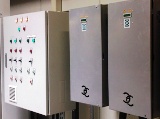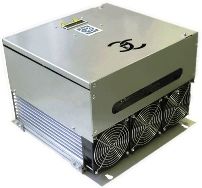Why does the motor need EnergySaver?
 The article discusses the capabilities of the «EnergySaver» type controller optimizer for controlling asynchronous motors.
The article discusses the capabilities of the «EnergySaver» type controller optimizer for controlling asynchronous motors.
In industry, approximately 60% of all electricity is consumed by motors of various types, of which asynchronous ones account for more than 90%. Compared with other types, asynchronous motors have a relatively simple design, low cost, easy operation, high efficiency and reliability.
But in technology, something is rarely given for free (but in life, too). The main problem of asynchronous motors is the inability to match the mechanical torque of the motor shaft with the mechanical load, both during start-up and during operation. When turned on, the motor picks up the speed of operation in a fraction of a second, while the mechanical moment is 1.5-2 times higher than the nominal value, and the current is 6-8 times. Large inrush currents load the networks and, most importantly, significantly shorten the life of the motor.
Another problem is related to the mode of operation.Choosing the power of the engine from the starting conditions of the mechanisms, in the nominal mode it works under load, i.e. with low shaft torque. Mechanisms often operate in cyclic mode, with low load factors (LO). In this case, the engine usually idles most of the time. In this case, electrical energy is spent inefficiently.
The first of the described problems was solved with the help of starting rheostats and with the development of semiconductor technology - semiconductor soft-start circuits. These technical means allow you to start the engine under severe starting conditions, but what to do with the variable load on the shaft in operating mode? In addition, the process of stopping the motor should not be neglected — the energy stored in the stator is "discharged" in the form of a high-voltage pulse, which damages the insulation of the winding and the switching equipment.
The emergence frequency converters, which allows you to vary the engine speed over a wide range, seems to have completely eliminated all the problems of the induction motor. The frequency drive allows you to accelerate the motor according to any law, continuously monitor the load in operating mode and smoothly stop the motor. In selected applications, energy savings of up to 70% can be achieved through optimal shaft load management.
But for the wide capabilities of the frequency drive you have to pay with its high price. This product has redundant functionality that allows the implementation of complex engine algorithms. It is this flexibility that becomes a hindrance in simple applications. The frequency converter is not a finished product.It is used as part of control systems in which the cost of additional elements (sensors, controllers, programmers) is often comparable to the cost of the converter itself.

The powerful microprocessor control unit included in the EnergySaver controller provides complete control of the motor during start-up, operation and shutdown. The control principle is based on maintaining a constant value of the mechanical load moment on the shaft. By measuring the angle of displacement between current and voltage, the control unit decreases or increases the voltage of the motor, changing its power.
The product is functionally complete, it is enough to connect the input and output wires, and the motor can be controlled using the default values of the manufacturer's settings. The controller combines the flexibility of a frequency drive with low cost soft starters. With a price 25-30% higher than the starter, «EnergySaver», in addition to the standard protective functions of the equipment against overload and short circuit, protects the motor from breaking the sequence of phases, losing one of the phases. Because internal voltage and current control is performed separately for each phase, the controller eliminates supply voltage or load imbalance.
All these properties allow the controllers to be widely used to control asynchronous motors, ensuring their long-term operation and saving electrical energy.
